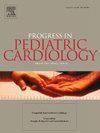Histoplasma endocarditis in a prosthetic pulmonary valve: A case report
IF 0.8
Q4 PEDIATRICS
引用次数: 0
Abstract
Introduction
Infective endocarditis (IE) following transcatheter pulmonary valve placement is a significant concern. Fungal endocarditis, though rare, poses significant diagnostic and therapeutic challenges, particularly when caused by Histoplasma capsulatum.
Case report
We present a 24-year-old female with tetralogy of Fallot (ToF) and a history of transcatheter prosthetic pulmonary valve replacement, who developed IE secondary to active histoplasmosis. Initial symptoms included worsening fatigue and jaundice, leading to hospitalization. Echocardiography revealed new stenosis of the pulmonary valve, prompting further investigation. Despite negative blood cultures, serological and molecular tests for histoplasmosis were positive, confirming the diagnosis. Treatment commenced with amphotericin B, followed by surgical valve replacement two weeks later, revealing hyphal elements indicative of H. capsulatum. The patient subsequently received prolonged antifungal therapy with itraconazole with near complete resolution of symptoms and a mild residual gradient.
Conclusion
This case emphasizes the necessity for heightened awareness of fungal pathogens in patients with prosthetic devices, particularly in the context of culture-negative endocarditis. Early diagnosis and intervention, including surgical resection and appropriate antifungal treatment, are critical for improving patient outcomes.
假肺瓣膜组织浆体心内膜炎1例
经导管置入术后的感染性心内膜炎(IE)是一个值得关注的问题。真菌性心内膜炎虽然罕见,但对诊断和治疗提出了重大挑战,特别是当由荚膜组织浆体引起时。病例报告我们报告了一位24岁的女性法洛四联症(ToF)和经导管假体肺瓣膜置换术史,她发展为活动性组织胞浆菌病继发的IE。最初的症状包括疲劳和黄疸加重,导致住院治疗。超声心动图显示新的肺动脉瓣狭窄,提示进一步调查。尽管血液培养呈阴性,但组织浆菌病的血清学和分子检测呈阳性,证实了诊断。开始使用两性霉素B治疗,两周后进行瓣膜置换术,发现菌丝成分表明荚膜芽孢杆菌。患者随后接受伊曲康唑长期抗真菌治疗,症状几乎完全缓解,残留梯度轻微。结论本病例强调了在假体患者中提高真菌病原体意识的必要性,特别是在培养阴性心内膜炎的背景下。早期诊断和干预,包括手术切除和适当的抗真菌治疗,是改善患者预后的关键。
本文章由计算机程序翻译,如有差异,请以英文原文为准。
求助全文
约1分钟内获得全文
求助全文
来源期刊

PROGRESS IN PEDIATRIC CARDIOLOGY
PEDIATRICS-
CiteScore
0.90
自引率
11.10%
发文量
69
审稿时长
75 days
期刊介绍:
Progress in Pediatric Cardiology is an international journal of review presenting information and experienced opinion of importance in the understanding and management of cardiovascular diseases in children. Each issue is prepared by one or more Guest Editors and reviews a single subject, allowing for comprehensive presentations of complex, multifaceted or rapidly changing topics of clinical and investigative interest.
 求助内容:
求助内容: 应助结果提醒方式:
应助结果提醒方式:


